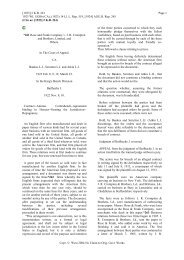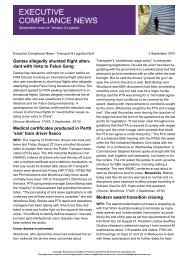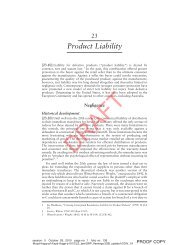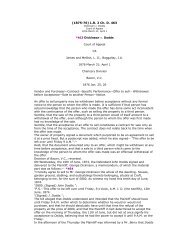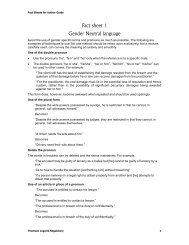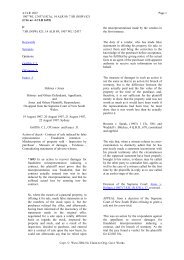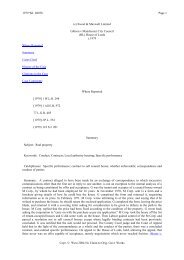Tesco v Constain - Thomson Reuters
Tesco v Constain - Thomson Reuters
Tesco v Constain - Thomson Reuters
Create successful ePaper yourself
Turn your PDF publications into a flip-book with our unique Google optimized e-Paper software.
2003 WL 21729349 Page 732003 WL 21729349 (QBD (T&CC)), [2003] EWHC 1487(Publication page references are not available for this document.)242. I shall refer to other authority falling in datebetween the two cases, but it is logical to comestraight after the citation from the speech of LordFraser in Pirelli General Cable Works Ltd. v. OscarFaber & Partners to the decision of the HPrivyCouncil in Invercargill City Council v. Hamlin[1996] AC 624, which was an appeal from theCourt of Appeal of New Zealand. An issue in thatcase was when the cause of action of a buildingowner against a local authority for negligentdischarge of its functions of inspecting a houseunder construction accrued. Under English law, inthe light of the decision of the House of Lords inMurphy v. Brentwood District Council, therewould be no cause of action at all in suchcircumstances, but, as the Privy Council madeplain, the common law of New Zealand hasdeveloped differently from English law in thisrespect. The house construction of which gave riseto the claim was built in 1972, cracks began toappear in 1974, but the action was not commenceduntil 1990. The advice of the Privy Council wasgiven by Lord Lloyd of Berwick. At page 648C-649C Lord Lloyd said, so far as is presentlymaterial:--"Once it is appreciated that the loss in respect ofwhich the plaintiff in the present case is suing isloss to his pocket, and not for physical damage tothe house or foundations, then most, if not all thedifficulties surrounding the limitation question fallaway. The plaintiff's loss occurs when the marketvalue of the house is depreciated by reason of thedefective foundations, and not before. If he resellsthe house at full value before the defect isdiscovered, he has suffered no loss. Thus in thecommon case the occurrence of the loss and thediscovery of the loss will coincide ...This approach avoids almost all the practical andtheoretical difficulties to which the academiccommentators have drawn attention, and which ledto the rejection of the HPirelli decision [1983] 2 AC1 by the Supreme Court of Canada in the Kamloopscase, 10 DLR (4th) 641. The approach is consistentwith the underlying principle that a cause of actionaccrues when, but not before, all the elementsnecessary to support the plaintiff's claim are inexistence. For in the case of a latent defect in abuilding the element of loss or damage which isnecessary to support a claim for economic loss intort does not exist so long as the market value ofthe house is unaffected. Whether or not it is right todescribe an undiscoverable crack as damage, itclearly cannot affect the value of the building onthe market. The existence of such a crack is thusirrelevant to the cause of action. It follows that thejudge applied the right test in law ....It is regrettable that there should be anydivergence between English and New Zealand lawon a point of fundamental principle. Whether thePirelli case [1983] 2AC 1 should still be regardedas good law in England is not for their Lordships tosay. What is clear is that it is not good law in NewZealand."243. The comments of Lord Lloyd in InvercargillCity Council v. Hamlin which I have quoted in thepreceding paragraph put the first instance judge inEngland and Wales in a strange position. It wasfundamental to the reasoning of the House of Lordsin Pirelli General Cable Works Ltd. v. Oscar Faber& Partners as to when a cause of action innegligence accrued in respect of defects in abuilding that the nature of that damage wasphysical. Later decisions of the House of Lordshave recognised that that is a mischaracterisationand that properly such defects should be regardedas giving rise to economic loss. Thatnotwithstanding, the decision in Pirelli GeneralCable Works Ltd. v. Oscar Faber & Partners hasnot been formally reconsidered by the House ofLords and remains technically binding upon lowercourts as the law of England. Although, howeverregrettable, it is possible conceptually for thecommon law of New Zealand to be different fromthe common law of England and Wales, what is notlogically possible is for the characterisation of adefect in a building which has not caused damageto person or property to be different in England andWales, on the one hand, and in New Zealand, onthe other. The difficulties of the first instance judgeare compounded, rather than reduced, by aconsideration of the comments which Lord Keith ofKinkel made in Murphy v. Brentwood DistrictCouncil at page 466D-G concerning the decision inPirelli General Cable Works Ltd. v. Oscar Faber &Partners. I have quoted the relevant commentsearlier in this judgment. One thus seems to have atleast two fairly broad hints, one from Lord Keithand those who agreed with him in Murphy v.Brentwood District Council, and the other fromLord Lloyd and those who concurred in the adviceof the Privy Council in Invercargill City Council v.Hamlin, that, should it ever be necessary to do so,the House of Lords may well be disposed toreconsider the decision in Pirelli General CableWorks Ltd. v. Oscar Faber & Partners. Meanwhilethe reasoning underlying it has been recognised asbeing flawed.244. A decision which followed Pirelli GeneralCable Works Ltd. v. Oscar Faber & Partners wasthat of the HCourt of Appeal in LondonCongregational Union Incorporated v. Harriss &Harriss [1988] 1 All ER 15. In that case thedefendants were architects who were engaged bythe claimants in 1969 to design a church hall. Afterit was constructed in 1970 the church hall floodedCopr. © West 2004 No Claim to Orig. Govt. Works



